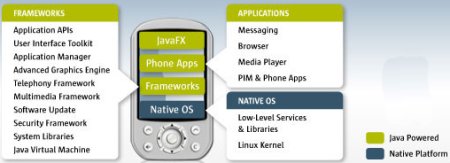Sun demo’s RIA tools on Android
May 8, 2008 — by Eric Brown — from the LinuxDevices Archive — views At this year's JavaOne conference, Sun Microsystems demonstrated its JavaFX technology for creating Rich Internet Applications (RIAs). The Linux-based, GPL-licensable technology will first appear for desktop operating systems (OSes) this Fall, says Sun, with JavaFX Mobile and JavaFX TV due in Spring 2009.
At this year's JavaOne conference, Sun Microsystems demonstrated its JavaFX technology for creating Rich Internet Applications (RIAs). The Linux-based, GPL-licensable technology will first appear for desktop operating systems (OSes) this Fall, says Sun, with JavaFX Mobile and JavaFX TV due in Spring 2009.
Sun announced JavaFX at last year's JavaOne. At the time it suggested that the mobile version would come first, but now the desktop version has been given priority. JavaFX appears to compete with other emerging RIA technologies including Adobe's AIR (Adobe Integrated Runtime), which is based on Webkit, and Microsoft's Silverlight cross-platform multimedia plugin, which Nokia recently announced it would support in many of its phones and devices, including its Linux-based Nokia N810 Internet tablets.

JavaFX development environment
(Click to enlarge)
At this year's JavaOne, Rich Green, Sun's EVP of Software, led a series of demonstrations that included the JavaFX Mobile version shown on a prototype phone running the Java-based Android phone stack developed by Google and the Open Handset Alliance (OHA). Most Linux-based phone distributions and stacks are either partially based on Java or tightly linked to it. For example, Aplix is the lead developer in creating a Java SDK for the recently released LiMo Foundation spec.
The JavaFX demos shown at JavaOne include:
- Movie Cloud — a 3D sphere that renders dozens of high-definition videos simultaneously
- Photo Flocker — photo tagging and display software, enabling search by photo tag and providing cascading montage of resulting shots
- The Connected Life — creating RIAs across multiple screens, including Web browser, social network, desktop OS, and mobile phone
JavaFX Mobile is based in part on the all-Java mobile phone OS, SavaJe, which Sun acquired in April of last year. Unlike most Java-enabled phones, which typically limit Java's role to providing a secure, managed sandbox for user-installed applications, JavaFX Mobile will use Java for most processes, including a UI toolkit, telephony and security middleware, user applications, and media players. The Linux component consists only of a kernel and “low-level services and libraries.”
According to Green, JavaFX will enable dynamic content, services, and application mash-ups across multiple platforms, making it easier to develop an application once, and then seed the RIA across different types of devices. As with Google's Android, it was also touted as a way to generate revenue through advertising on mobile applications.
New details on JavaFX Script
Sun reiterated its plans to roll out a declarative scripting language called JavaFX Script, and added new information on the environment. The open-source JavaFX Script is intended to streamline the development of “RIAs for desktop, mobile, TV, and other consumer devices,” says Sun, leveraging Java Swing, Java 2D, and Java 3D. It will also be compatible with the NetBeans integrated development environment (IDE) (see diagram above).
By comparison to Swing, the structure of JavaFX Script's programmer's code “closely matches the actual layout of the GUI, making it tangibly easier to understand and maintain,” claims Sun. To maintain performance, GUI components and back-end application objects are implemented in Java, while JavaFX Script's role is to create, configure, and link the components. The company says it will launch a JavaFX preview program this summer and create a website for scripters and Web developers, as well as a forum for preview feedback.

JavaFX Mobile architecture
In a related announcement today, Sun said it had forged a multi-year agreement with On2 Technologies to integrate On2's TrueMotion video codec into JavaFX. JavaFX Desktop will include TrueMotion when it ships this Fall, says Sun.
Stated Green, “The JavaFX runtime environment is designed from the ground up to support high fidelity media, empowering content authors to deliver media-rich content and applications across all the screens of your life. Java technology is now ready for the new creative audiences that have emerged in response to consumer demand for rich content — scripters, social application creators, designers, content authors and consumers.”
According to Sun, Java powers 91 percent of desktop browsers and computers, and is built into two billion mobile phones, nine million TVs, and 13 million Blu-ray Disc players.
Earlier this week, Sun officially released the “open-source” version of its Solaris OS, called OpenSolaris.
Availability
The desktop version of JavaFX is set to ship this Fall, with the mobile and TV versions due next Spring, says Sun. No information was given on the availability of JavaFX Script, but a “preview” will be posted sometime this summer. More information on JavaFX may be found on this developers page, or at the general-interest JavaFX site.
This article was originally published on LinuxDevices.com and has been donated to the open source community by QuinStreet Inc. Please visit LinuxToday.com for up-to-date news and articles about Linux and open source.